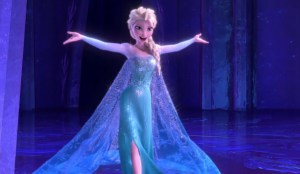
“Let it go, let it go,” will likely be a lyric that never leaves our heads thanks to Disney’s best file ever, Frozen. Now, I jumped on the Frozen bandwagon quite late and somewhat backwards. I am a huge Idina Menzel fan and was mesmerized (as usual) by this current Menzel hit. All of the hoopla about the movie made me curious as I haven’t liked a Disney movie since Little Mermaid. Serendipitously, I walked into Best Buy and there it was, the Blu-Ray edition, on sale for like $15.00. I succumbed to the temptation, purchased it and after having watched it a few times (and done my own crazy rendition of Let It Go), am changed after watching it.
Here’s why:
So have you ever had something about yourself or something that happened to you that you didn’t like and felt you couldn’t tell anyone? I have had my share. I really related to Elsa when she was told to “conceal don’t feel” by her oh so unconditionally loving parents. Whether it was conditional parents or society at large, there are so many things we are “told” not to disclose as people may think badly of you and/or you may hurt someone in the process (like Elsa accidentally did with Anna) the mere shame of having this situation causes you to become silent. What was real interesting was that Elsa (and her parents) were told that “fear is your greatest enemy,” however, fear was exactly the emotion in charge. Subsequently, fear drove Elsa to shut herself off from the world, including her best friend and little sister. No amount of begging (or bribes to build a snowman) from Anna made Elsa budge from her den of secrecy and fear. How many of us do the same for fear of judgment and/or hurting someone we love?
So these shining examples of parents die (I actually cheered when it happened) and Elsa is forced to become who she was destined to be, the Queen. Reluctantly, Elsa comes out of hiding and struggles to interact with folks in the real world. I actually felt the terror as she made her way through the crowd and more so during her coronation. She was then forced to take off her gloves (which served as a shield for her ice powers, (seriously Disney? Calling Reed Richards for some unstable molecule clothing) and what she actually feared, came to pass. People saw what she was capable of. Instead of facing judgment, she decided to run and hide.
Now the next part, they actually got somewhat right. Once her secret was out, she was liberated and claimed her power, hence the titillating jubilee of “Let It Go.” As she sings about letting things go and not being the girl she always had to be, she claims her power and transforms into a powerful being, creating a beautiful castle with matching dress. Now, what I approve of is that once we claim our power and accept our perceived affliction, we can transform and become powerful individuals. Where Disney got it wrong was that she continued to hide from the rest of the world (yes, I know, it would have cut the movie in half.)
In comes that annoying little sister, Anna, to search for her big sister. Now as annoying as she may have been, especially falling in love with the first guy she meets with Johnathan Groff’s voice (I feel you Anna), she was probably the hero of the story. Despite many obstacles, she made her way to save her sister from herself.
When Anna finally reached the ice castle (accompanied by Olaf, Sven and Kristoff), she implored Elsa to just come back and be with her. She basically told Elsa that no one cared about her power. Elsa, still not having let it go, held on to her shame about her affliction and banished Anna from the castle, creating this huge monster to keep them away. This reminds me of the monsters we create in our heads about the things we don’t let go of. This outward manifestation is actually how we perceive ourselves in similar situations. Elsa also created cute little Olaf, representing the duality of our psyche and our capacity to create good despite our negative self-perception.
The last thing I want to touch on is the drastic change Disney made with this movie. Usually, it is the handsome prince rescuing the fair maiden by an act of true love. This time, it wasn’t true love that saved the fair maiden (which Anna never really was) but an act of unconditional love that saved the day. No kiss was needed, just the pure love of one sister to another. Once Elsa saw the power of unconditional love, she was then able to “let it go” and make her final transformation – being and fully accepting who she is, “affliction” and all.
Some of you may be thinking that I am so overthinking this movie. While this may be true, I think that if we took a good look at the lessons here, we can make the world a better place. This movie teaches us about accepting who we are (flaws and all), transforming our lives despite our circumstances, perseverance, loving unconditionally, and the power of unconditional love. If we can incorporate these lessons into our lives, we can then truly “Let It Go.”

